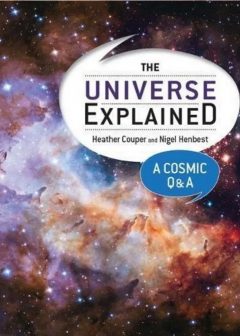The Universe explained – a cosmic Q&A
| By Heather Couper & Nigel Henbest | Reviewed by Philip Jennings |
| Firefly Books 2018 | 288 pages |
| Price £16.95 | ISBN:978-0-228-10082-9 |

‘From America to Australia, China to Columbia, the Q&A session of our lectures is often the best part.’ So begins the introduction to this ambitiously titled book from the prolific writing team of Heather Couper and Nigel Henbest, which proceeds to pose and answer questions with all the conversational enthusiasm of such an event.
This is a book aimed predominantly at beginners, providing answers to 185 questions ranging from practical observing advice (‘What is a planisphere?’), to spaceflight and cosmology (‘Can you travel through a wormhole?’). More experienced observers may purchase it in the hope of getting friends or family hooked on their passion – a task for which the lively approachability of the Q&A format is well suited.
There are echoes here of the late Sir Patrick Moore’s memorable 2008 question compendium Can you play cricket on Mars? (for those wondering, his detailed answer to the titular question begins: ‘There is no reason why not, but there are obvious problems…’). Couper and Henbest’s questions are generally less whimsical, but with either one or two pages devoted to each, the answers are afforded enough space to include humour and entertaining digressions.
For the most part, the authors resist the temptation to pick questions to fit the answers, which is a common fault of the Q&A format. The majority of queries are those that beginners are likely to ask, addressing sources of confusion forgotten by many communicators in astronomy (e.g. ‘Is the North Star the brightest star?’). The book is well illustrated and the two-page glossary of terms, although perhaps a little short, demonstrates the authors’ talents in communicating complex ideas with accessible language.
The historical and scientific narratives that typify similarly-pitched introductory guides to astronomy, binding diverse topics into a single thread, are absent: a casualty of the Q&A format. However, the book’s charm lies in this informal approach; it is possible to dip into any page without getting hopelessly lost in concepts introduced previously. Helpful categorisation of questions according to topic, each with a contents page, ensures the many entries are navigable.
This is a lively yet information-rich tour of astronomy that is sure to inspire many to pursue its concepts further.
Philip Jennings is Editor of the Journal and a keen lunar and planetary observer.
| The British Astronomical Association supports amateur astronomers around the UK and the rest of the world. Find out more about the BAA or join us. |
